-
Paper Information
- Paper Submission
-
Journal Information
- About This Journal
- Editorial Board
- Current Issue
- Archive
- Author Guidelines
- Contact Us
International Journal of Energy Engineering
p-ISSN: 2163-1891 e-ISSN: 2163-1905
2022; 12(1): 23-28
doi:10.5923/j.ijee.20221201.03
Received: May 14, 2022; Accepted: May 30, 2022; Published: Jun. 13, 2022

Influence of Binder Concentration on the Combustion Properties of Non-Carbonized Fuel Briquettes from Sawdust
Abdullahi S. B. Gimba 1, Abdu Zubairu 2, Wasiu A. Ishaq 2, Khadija S. Ibrahim 1, Ayuba Salihu 1
1Department of Petroleum and Gas Engineering, Nile University of Nigeria, Abuja Nigeria
2Department of Chemical Engineering, University of Maiduguri, Borno State, Nigeria
Correspondence to: Abdu Zubairu , Department of Chemical Engineering, University of Maiduguri, Borno State, Nigeria.
| Email: |  |
Copyright © 2022 The Author(s). Published by Scientific & Academic Publishing.
This work is licensed under the Creative Commons Attribution International License (CC BY).
http://creativecommons.org/licenses/by/4.0/

Biomass residues from agricultural and forestry sources are widely produced in many developed and developing economies including Nigeria. These residues are often inefficiently managed; causing extensive adverse environmental and health related problems. Typical of such biomass residues are coffee husk, coir pith, jute sticks, bagasse, groundnut shells, mustard stalks, cotton stalk and sawdust among others. This work elucidates the use of sawdust to produce high density non-carbonized fuel briquettes using cassava starch as binder at medium pressures. Five different grades of briquette were produced with different binder concentrations of 6, 10, 14, 19 and 24% w/w respectively. Characterization was carried out for the synthesized briquettes and their properties were determined. The results show that the fixed carbon of the briquette grades produced range from 12.67-34.66%, while the ash contents of the briquette samples for the binder concentrations investigated range from 20-30%. The bulk density of the briquette produced range from 229.93-308.05kg/m3. The moisture content ranges from 5.34-8.49% respectively. The non-carbonized briquettes samples calorific values range from 5.86-6.87MJ/kg.
Keywords: Briquettes, Sawdust, Binder, Calorific Value, Ash Content
Cite this paper: Abdullahi S. B. Gimba , Abdu Zubairu , Wasiu A. Ishaq , Khadija S. Ibrahim , Ayuba Salihu , Influence of Binder Concentration on the Combustion Properties of Non-Carbonized Fuel Briquettes from Sawdust, International Journal of Energy Engineering, Vol. 12 No. 1, 2022, pp. 23-28. doi: 10.5923/j.ijee.20221201.03.
Article Outline
1. Introduction
- Huge quantities of agricultural and forestry residues are unavoidably generated at various stages of agricultural and forestry processes. In addition, there is rapid increase in volume and types of waste agricultural biomass produced due to increase intensive agricultural activities in the wake of population growth and improved living standards across the world [1]. Agricultural residues are produced during agricultural pre-planting operations like bush clearing in fields and farms, harvesting as well as other crops handling and post-harvest processing. On the other hand, forest residues like shrubs, leaves, roots, barks and branches from pruning operations are generated in forestry processes. Similarly, forest residues like stumps, defect logs, off cuts etc. are produced during logging operation. These biomass residues are widely generated in Nigeria in particular from both sources. The major residues include sawdust, rice-husk, coffee husk, coir pith, jute sticks, bagasse, groundnut shells, mustard stalks and cotton stalks. Of particular interest is the saw dust, a milling operation residue, is readily available in vast quantity across the six geo-political regions of Nigeria [2]. Biomass wastes in Nigeria are often inefficiently managed leading to widespread pollution to the environment with its concomitant health problems. The varying categories of these wastes is becoming a burgeoning menace as rotten waste agricultural biomass emits methane and leachate; whereas indiscriminate open burning by the farmers to clear the lands generate CO2 and other toxic pollutants [3]. In addition, the direct burning of loose agro-residues in conventional grates is associated with very low thermal efficiency and widespread air pollution and a large percentage of unburnt carbonaceous ash has to be disposed-off. Consequently, there is growing concerns related with environmental pollution and emission of the greenhouse gases; as such measures to limit such emissions are continuously sought. Recently, biomass is seen as the most promising alternative energy source to mitigate environmental degradation and ensure energy security [4].
2. Background Theory
2.1. Agricultural Biomass Residue
- The term biomass is derived from two Greek words “bio” meaning “life” and “maza” meaning “mass”; which refers to organic materials that are non-fossil and biodegradable primarily derived from plants, animals and micro-organism. Biomass includes all organic matter that exists on the biosphere produced by solar energy (photosynthesis) that stored sunlight in the form of chemical energy. Biomass is commonly recognized as an important renewable energy, which can be released via direct or indirect combustion [5]. Biomass comes from many different sources including agricultural wastes (straw, animals’ dung, husks of all kinds – of rice, grapes, walnut, etc.), wood and wood wastes (hubs, sawdust, paddles, chips), energy crops (poplar, willow, willow trees, seed and rape), municipality solid wastes and microbial algae [6]. Agricultural residues are produced during harvesting and other agricultural pre-planting operations like bush clearing in fields and farm. Biomass resources produced during such operations include residues from cereals, rhizomic crops and sugarcane. In postharvest processing of crops large quantities of by products are generated. Wood residues generated by management of perennial crop plantations such as pruning and replanting of trees (rubber, coconut, palm oil) are also sources of biomass [2]. Wood sawdust is a ubiquitous biomass originating from furniture factory and wood working. The sawdust generated by these manufacturers usually are irregular in shape and size, and even contains small wood bricks. Wood sawdust can be made into biomass briquette or pellet. The sawdust briquettes can be used in home heating stove or industrial boilers. In these circumstances sawdust represents raw material for the manufacture of solid fuel [6].
2.2. Biomass Energy Extraction
- Biomass is often directly combusted as fuel in domestic and industrial applications to either generate steam or to provide heat. Often the solid biomass will undergo physical processing such as cutting, chipping, briquetting, etc. but retains its solid form. Biomass could be converted to biogas; which primarily involves the anaerobic digestion of biomass material (i.e., decomposition of the biomass substance in limited or complete absence of oxygen). The biogas produced is a combustible gas that is mainly methane. Other common feedstocks for producing biogas are animal and municipal solid waste.Energy could also be extracted from biomass via the generation of liquid biofuel. These liquid biofuels are produced by subjecting biomass materials to certain physical and or chemical processes to produce combustible liquid fuel. Biofuels are renewable, environmentally friendly energy resources.
2.3. Non-carbonized Briquettes from Biomass
- Briquetting is a biomass conversion technology into fuel that improves the handling characteristics (bulk density), calorific value etc. of biomass material. Consequently, biomass briquetting reduces transportation cost and increases the net calorific value. On the basis of non-carbonized compaction, the briquetting technologies can be divided into:§ High pressure compaction§ Medium pressure compaction with a heating device§ Low pressure compaction, with a binderBriquetting and extrusion both represent compaction i.e., the pressing together of particles in a confined volume. If fine materials which deform under high pressure are pressed, no binders are required. The strength of such compacts is caused by van der Waals’ forces, valence forces, or interlocking. Natural components of the material may be activated by the prevailing high-pressure forces to become binders.In this work, sawdust was used to produce briquettes under low pressure compaction with the aid of cassava starch as binder.
3. Materials and Methods
3.1. Materials
- Sawdust was collected from a local wood processing factory in Maiduguri metropolis. While cassava starch was purchased from Monday market in Maiduguri, Borno State.
3.2. Methods
3.2.1. Biomass Feedstock Preparation
- The collected sawdust was manually sorted to removed undesired materials; and oven dried to reduce the moisture content of the feedstock.
3.2.2. Crushing and Sieving
- The dried biomass material was grinded to reduce the sizes of the feedstock and sieved to achieve even size distribution of the feedstock. The sieved sawdust was measured and divided into five (5) batches of 1kg each.
3.2.3. Binder Preparation
- Five (5) different binder concentrations were produced by dissolving 60, 100, 140, 190 and 240g of cassava starch in 0.5 litre of water. Initially, the cassava starch was partially dissolved in 100 ml of warm water to form a slurry, and then 400 ml of water was added, the mixture was brought to boil, while gently stirring the mixture until smooth homogeneous gelatinized starch solution was produced.
3.2.4. Sawdust-Binder Mixing
- For each of the five (5) binder grades solutions, a batch of 1kg of the finely grinded sawdust was added and poured into a mixing bowl while still warm and thoroughly agitated. The sieved sawdust powder was mixed with the binder in such a way that every particle of the sawdust material was coated with a film of the binder.
3.2.5. Briquette Production and Drying
- The starched-mix material was dispensed in to a cylindrical briquetting mould 5 cm in diameter, fabricated from a recycled steel pipes and manually pressed. Five (5) grades of the briquettes were produced corresponding to the five different binder preparations. The five different briquette grades with binder concentration of 6.0, 10.0, 14.0, 19.0 and 24.0% w/w produced were labelled A, B, C, D and E respectively. The moulded briquettes were placed on clean aluminium trays and were sun dried for 2 days. The sample of the dried briquettes produced are shown in Figure 1.
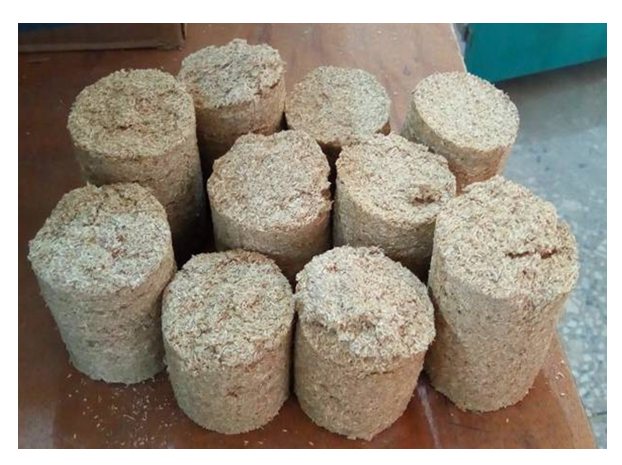 | Figure 1. Non-carbonized briquettes from sawdust |
3.2.6. Evaluation of Ash Content
- A 2g portion of the briquette sample was placed in a pre-weighed porcelain crucible and transferred into a preheated muffle furnace set at a temperature of 600°C for 1hour, after which the crucible and its contents were transferred to a desiccator and allowed to cool. The crucible and its content were reweighed. The percentage ash content (AC) was calculated using equation (1) [7]:
 | (1) |
3.2.7. Evaluation of Moisture Content
- A 2g portion of the briquette sample was weighed out in a wash glass. The samples were placed in an oven for 2 hours at 105°C after which the sample was removed cooled and re-weighed. The moisture content (MC) was determined using equation (2) [8]:
 | (2) |
3.2.8. Evaluation of Bulk Density
- The method of explained in [9] was adopted; an empty container was weighed using a digital balance, the container was filled with the sample and the material was slightly compacted to ensure the absence of large void spaces. The container and the sample were then weighed. The wet bulk density of the sample was calculated using equation (3):
 | (3) |
3.2.9. Evaluation of Volatile Matter
- A 2g portion of the briquette sample was heated to about 300°C for 10 minutes in a partially closed crucible in a muffle furnace. The crucible and its content were retrieved and cooled in a desiccator. The difference in weight was recorded and the volatile matter (VM) was calculated using equation (4) [8]:
 | (4) |
3.2.10. Evaluation of Fixed Carbon
- The fixed carbon (FC) content of the briquette sample was evaluated using equation (5) [7]:
 | (5) |
3.2.11. Evaluation of Calorific Value
- The calorific value or the heating value (HV) of the briquette sample was evaluated using equation (6) [7]:
 | (6) |
3.2.12. Evaluation of Briquette Yield
- The briquette yield can be determine using equation (7) [10]:
 | (7) |
4. Results and Discussion
4.1. Effects of Binder Concentration on Briquette Yield
- The effect of the binder concentration on the yield of briquette is shown in Figure 2. The main role of the binder is to strengthen the briquettes. It could be observed that the yield increases almost monotonically with increase in the binder concentration.
 | Figure 2. Effects of Binder Concentration on Briquettes Yield |
4.2. Effects of Binder Concentration on Fixed Carbon
- Binder concentration influence the carbon content of the briquettes. The highest carbon content was at 24% binder concentration, lowest fixed carbon was achieved at 10% concentration. The profile of the results is shown in Figure 3. It can be observed that carbon content increases with increase in binder concentration. Similar trend was observed for other type of biomass in previous work [4].
 | Figure 3. Effects of Binder Concentration on Fixed Carbon |
4.3. Effects of Binder Concentration on Ash Content
- Influence of binder concentration on the ash content of the synthesized briquettes are shown in Figure 4. The effect of the binder concentration on the ash content shows that the maximum ash content was 30% and the minimum was 20%.
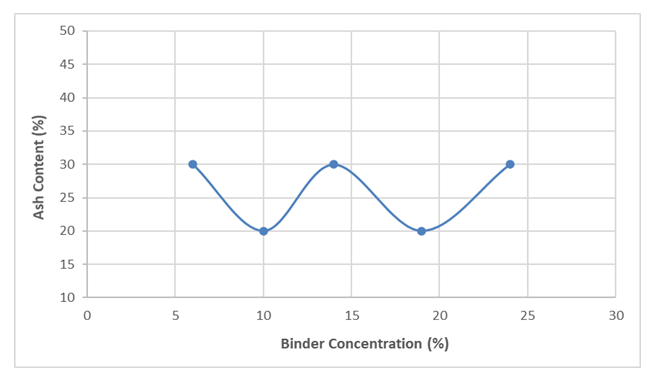 | Figure 4. Effects of Binder Concentration on Ash Content |
4.4. Effects of Binder Concentration on Bulk Density
- The influence of the binder concentration on bulk density is as shown in Figure 5. The bulk density varied only slightly with respect to the binder concentration at low binder concentrations and rather significant influenced at higher binder concentrations. Similar behaviour was observed for briquettes synthesized from corn cobs with cassava starch as binder [4]. Generally, the bulk density increases as the binder concentration increases.
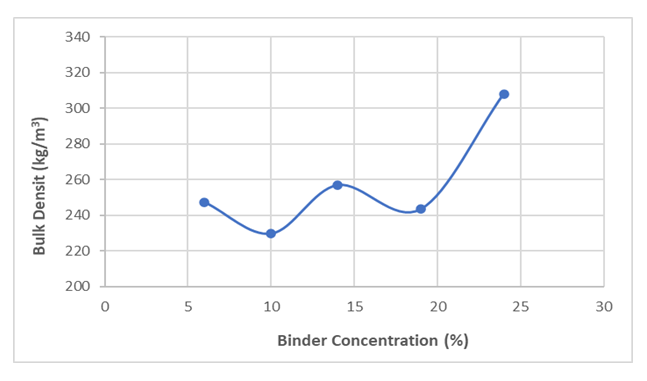 | Figure 5. Effects of Binder Concentration on Bulk Density |
4.5. Effects of Binder Concentration on Moisture Content
- The binder concentration slightly influences the moisture content of the briquette samples as can be seen from Figure 6. The maximum moisture content of the briquette was at 14% binder concentration and the minimum was at 24% binder concentration. Generally, the moisture content decreases as the binder concentration increases. The moisture content of all briquette samples synthesized fell with the literature [12] recommended value of 5-10% for good quality briquettes. Lower moisture content improves the heating value of the briquette.
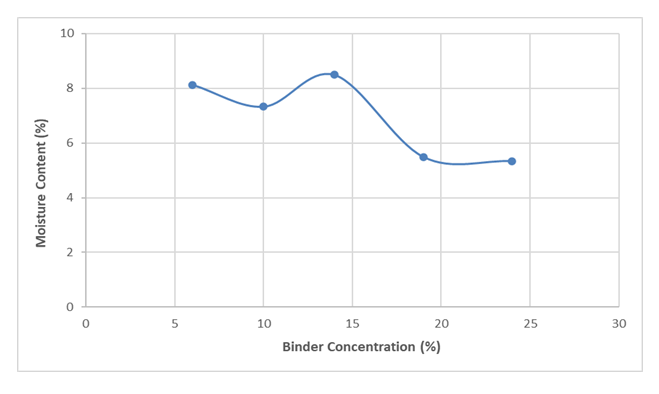 | Figure 6. Effects of Binder Concentration on Moisture Content |
4.6. Effects of Binder Concentration on Volatile Matter
- Figure 7 shows the influence of the binder concentration on the volatile matter of the synthesized briquettes. The maximum volatile matter was observed at 10% binder concentration. The volatile matter increase with binder concentration at lower binder concentration levels, and decreases at higher binder concentrations. Generally, it is asserted [13] that biomass has high volatile matter of 70-86%. All briquette samples synthesized in this work exhibit lower volatile matter, but within the levels obtained in other works [for briquettes from agricultural biomass residues [14].
 | Figure 7. Effects of Binder Concentration on Volatile Matter |
4.7. Effects of Binder Concentration on Calorific Value
- The calorific value (heating value or energy density) of the briquette is the amount of heat liberated per unit mass of the briquette. The influence of the binder concentration on the calorific values of the synthesized briquettes is as shown in Figure 8.
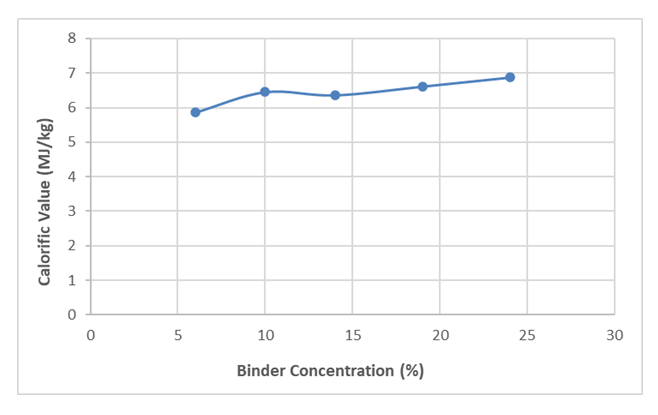 | Figure 8. Effects of Binder Concentration on Calorific Value |
5. Conclusions
- High energy density non-carbonized briquette fuel was produced from raw sawdust waste biomass. Five different briquette grades at various binder concentration were synthesized and characterized. The results show that the fixed carbon content of the briquette grades produced range from 12.67-34.66%, while the ash content of the briquette samples for the various binder concentrations investigated range from 20-30%. The bulk density of the briquette produced range from 229.93-308.05kg/m3, while the moisture content ranges from 5.34-8.49%. The non-carbonized briquettes samples have calorific value range from 5.86-6.87MJ/kg.
 Abstract
Abstract Reference
Reference Full-Text PDF
Full-Text PDF Full-text HTML
Full-text HTML